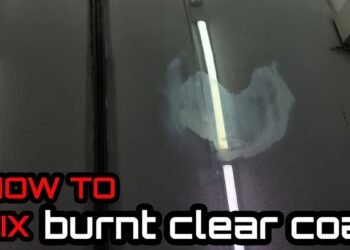If you want your car’s brake calipers to look as sharp as they perform, keeping them clean is the first step. Dirty, grimy calipers not only spoil your vehicle’s appearance but can also hide early signs of wear and tear.
You might think cleaning brake calipers is complicated or messy, but with the right approach, you can easily bring back their fresh, painted look. In this guide, you’ll discover simple, effective ways to clean your painted brake calipers safely and thoroughly—helping you protect your investment and make your wheels stand out.
Ready to give your brake calipers the attention they deserve? Let’s dive in.
Materials Needed
Preparing to clean and paint your brake calipers requires gathering the right materials. These tools and supplies ensure a smooth process and a professional finish. Using proper items helps remove dirt effectively and protects your calipers.
Brake Cleaner Spray
Choose a high-quality brake cleaner spray. It should dissolve brake dust, grease, and grime without leaving residue. This product is designed to work on metal surfaces safely.
Wire Brush
A wire brush removes heavy rust and stubborn buildup. It works well on tough spots that a softer brush cannot handle. Use it carefully to avoid damaging the caliper surface.
Detail Brush Or Toothbrush
Use a small detail brush or toothbrush for tight areas. These brushes reach corners and crevices where dirt collects. They help clean without scratching the paint or metal.
Isopropyl Alcohol (ipa)
Isopropyl alcohol wipes away any leftover dust or grease. It leaves the surface clean and ready for painting. Use it after the initial cleaning to ensure no residue remains.
Safety Gear
Wear gloves and eye protection to keep safe. Brake cleaner and dust can irritate skin and eyes. Safety gear prevents injury during the cleaning process.
Microfiber Cloths
Use microfiber cloths to dry and wipe the calipers. They absorb moisture well and do not scratch surfaces. Clean cloths help achieve a spotless finish before painting.
Preparing The Calipers
Preparing the brake calipers properly is essential before cleaning or painting them. This step ensures a smooth, long-lasting finish and prevents damage to the brakes. Taking time to prepare helps remove dirt, grease, and brake dust effectively. It also guarantees safety during the process.
Cooling The Brakes
Make sure the brakes are completely cool before starting. Hot brakes can cause burns and make cleaning products evaporate too fast. Wait at least 30 minutes after driving to let the calipers cool down. Touch the caliper gently to check the temperature. Only begin cleaning when the calipers feel cool to the touch.
Wearing Safety Gear
Always wear safety gear before working on brake calipers. Gloves protect your hands from chemicals and grime. Eye protection prevents dust or cleaner spray from getting into your eyes. Use a mask if you are sensitive to dust or strong smells. Safety gear keeps you safe and comfortable throughout the cleaning process.
Cleaning Steps
Cleaning painted brake calipers requires careful attention and the right steps. Proper cleaning removes dirt, brake dust, and grime. This keeps the calipers looking fresh and helps maintain their paint finish. Follow these simple cleaning steps to get the best results.
Applying Brake Cleaner
Start by spraying a commercial brake cleaner on the calipers. Use a generous amount to cover all surfaces. The cleaner breaks down brake dust and grease. Let it sit for a minute to loosen dirt. Avoid spraying on rubber parts to prevent damage.
Scrubbing The Surface
Use a wire brush or a detail brush to scrub the caliper. Focus on tight spots and crevices where dirt hides. Scrubbing removes stuck-on grime and rust. Work gently to protect the paint. Repeat spraying brake cleaner if needed.
Rinsing And Drying
Rinse the calipers with a gentle stream of water. This removes loosened dirt and cleaner residue. Avoid high-pressure water to protect paint and seals. Use microfiber cloths to dry the calipers completely. Drying prevents rust and water spots.
Final Wipe With Isopropyl Alcohol
Spray isopropyl alcohol on a clean cloth. Wipe all caliper surfaces to remove any leftover residue. Alcohol evaporates quickly and leaves a clean finish. This step prepares calipers for any additional coating or painting. Let the calipers dry fully before use.

Credit: www.reddit.com
Protecting Rubber Parts
Protecting rubber parts during the cleaning and painting of brake calipers is vital. Rubber components like seals, boots, and brake lines keep your braking system sealed and functioning. These parts can easily get damaged by harsh chemicals or heat. Damage may lead to brake fluid leaks or reduced brake performance. Taking steps to shield these parts helps maintain safety and extends component life.
Use Protective Barriers
Cover rubber parts with masking tape or plastic wrap before cleaning. This prevents contact with brake cleaner sprays and solvents. Masking tape is easy to apply and remove without residue. Ensure all rubber boots and seals are fully covered. Protective barriers save time repairing damaged rubber later.
Choose Rubber-safe Cleaners
Select brake cleaners labeled safe for rubber materials. Avoid strong solvents that cause swelling or cracking. Mild, water-based cleaners work well to remove dirt while protecting rubber. Always check product labels and test on a small area first. Rubber-safe cleaners help maintain flexibility and seal integrity.
Apply Heat Carefully
Brake caliper painting involves heat curing paint. Excessive heat harms rubber parts nearby. Keep rubber components away from direct heat sources. Use heat shields or remove rubber parts if needed. Controlled heat application ensures paint durability without rubber damage.
Lubricating Friction Points
Lubricating friction points in brake calipers helps maintain smooth brake function. It reduces wear and prevents squeaking noises. Proper lubrication keeps caliper parts moving freely and improves overall braking performance.
Applying the right lubricant protects metal surfaces from corrosion. It also prevents parts from sticking or seizing up over time. Regular lubrication extends the life of brake components and ensures safer driving.
Identifying Friction Points On Painted Brake Calipers
Focus on sliding pins, contact points, and the back of brake pads. These areas face constant movement and pressure during braking. Dirt and rust build-up here can cause uneven wear and brake noise.
Choosing The Correct Lubricant
Use high-temperature brake grease made for caliper parts. Avoid oil-based or general-purpose lubricants that can damage rubber seals. Silicone-based or synthetic greases offer good heat resistance and long-lasting protection.
How To Apply Lubricant Safely
Clean friction points before applying lubricant to remove dirt and old grease. Use a small brush or applicator to spread lubricant evenly. Avoid getting grease on painted surfaces to keep the finish clean and neat.
Benefits Of Regular Lubrication
Lubricated friction points reduce noise and vibrations. They help brake pads move smoothly and wear evenly. This maintenance step improves braking response and prevents costly repairs down the line.
Preparing For Painting
Preparing brake calipers for painting requires careful cleaning and surface preparation. This step ensures the paint sticks well and lasts longer. Proper preparation also prevents peeling and uneven finishes. Take your time to do it right.
Removing Calipers
Start by lifting the vehicle safely with a jack and secure it with stands. Remove the wheels to access the brake calipers. Use the correct tools to loosen and remove the caliper bolts. Carefully take off the calipers without damaging the brake lines. Place the calipers on a clean, stable surface for painting.
Sanding The Surface
Use sandpaper or a sanding tool to roughen the caliper surface. Focus on removing rust, old paint, and dirt. Sand until the surface feels smooth but slightly rough to the touch. This texture helps the paint bond better. Wipe away dust with a clean cloth before painting.
Tips For Maintaining A Showroom Shine
Maintaining the showroom shine of painted brake calipers keeps your car looking fresh and well cared for. Clean calipers highlight your vehicle’s style and add to its overall appeal. Regular attention prevents dirt and grime buildup that dulls the paint finish.
Simple steps help preserve that clean, glossy look. A bit of care goes a long way in keeping the paint bright and protected from harsh road conditions. Here are useful tips to maintain your painted brake calipers’ shine.
Use Gentle Cleaning Products
Choose cleaning sprays designed for painted surfaces. Harsh chemicals can damage the paint and cause peeling. A mild brake cleaner or soap with water works well to remove brake dust and dirt.
Clean Regularly
Washing your brake calipers often stops dirt from sticking and hardening. Frequent cleaning keeps the paint looking fresh. It also prevents rust from forming under the paint layer.
Dry Thoroughly After Washing
Moisture left on calipers may cause rust spots. Use a soft microfiber cloth to dry them completely. Proper drying protects the paint and metal beneath.
Apply A Protective Coating
Use a high-quality wax or sealant made for painted metal. This adds a shield against dirt and brake dust. It also enhances the shine and makes cleaning easier next time.
Avoid Harsh Road Conditions
Try to limit driving on muddy or salty roads. These conditions can damage the paint and promote corrosion. Rinse the calipers quickly if exposed to salt or heavy dirt.
Inspect For Damage Regularly
Check your calipers often for chips, scratches, or fading. Early spotting lets you fix small issues before they get worse. Touch up paint helps maintain a perfect look.

Credit: www.76vette.com

Credit: www.youtube.com
Frequently Asked Questions
What Can I Clean Brake Calipers With?
Clean brake calipers with a commercial brake cleaner spray and scrub using a wire or detail brush. Finish by wiping with isopropyl alcohol to remove residue. Always wear gloves and eye protection, and ensure calipers are cool before cleaning. Avoid harsh chemicals on rubber parts.
How To Restore Caliper Paint?
Clean calipers with brake cleaner and a wire brush. Remove rust using sandpaper. Wipe with isopropyl alcohol. Repaint with high-temperature caliper paint. Let dry fully before reassembling.
Can I Wash My Car After Painting Calipers?
Wait at least 24-48 hours after painting calipers before washing your car. Use gentle water pressure to avoid damaging the paint.
Is It A Bad Idea To Paint Your Brake Calipers?
Painting brake calipers is not bad if done properly. Use high-temp paint and clean surfaces well. Poor prep can cause peeling.
How Do I Clean Painted Brake Calipers Safely?
Use brake cleaner spray and a soft brush; avoid harsh chemicals on rubber parts.
Conclusion
Clean painted brake calipers improve your car’s look and protect parts. Regular cleaning keeps brake dust and grime from building up. Use the right tools and safety gear for best results. A clean surface helps paint stick well and last longer.
Take care not to harm rubber parts during cleaning. A little effort goes a long way in maintenance and style. Keep your calipers fresh and your car looking sharp every time.

















